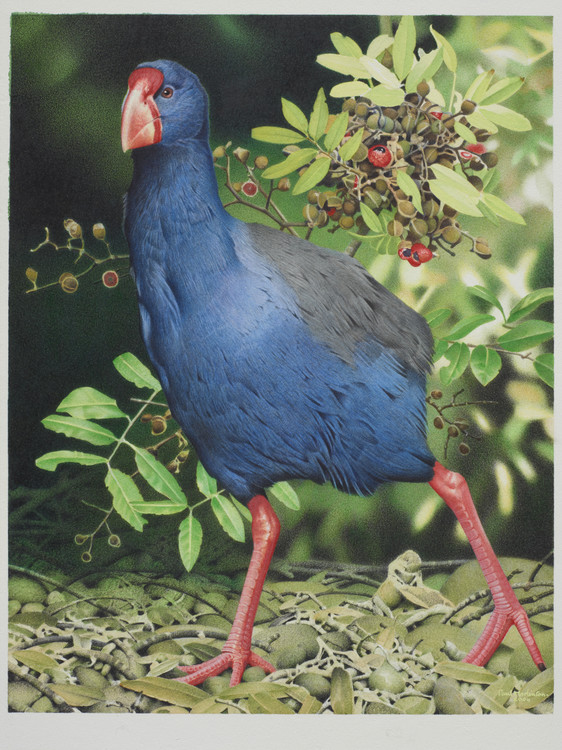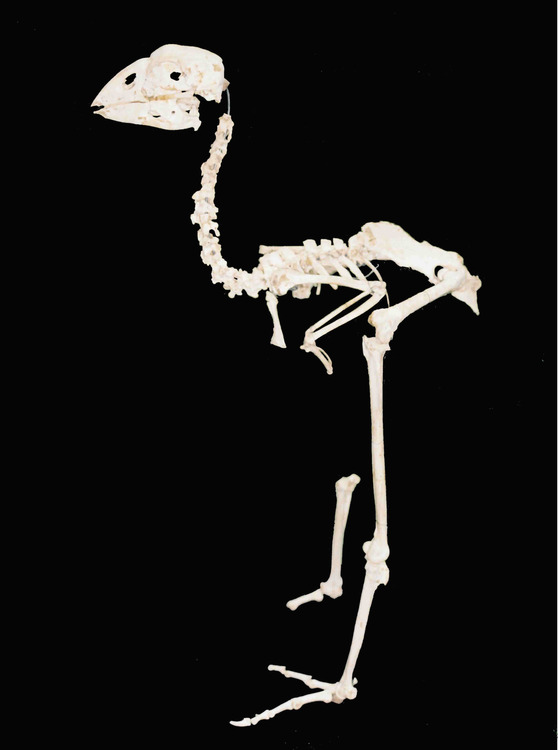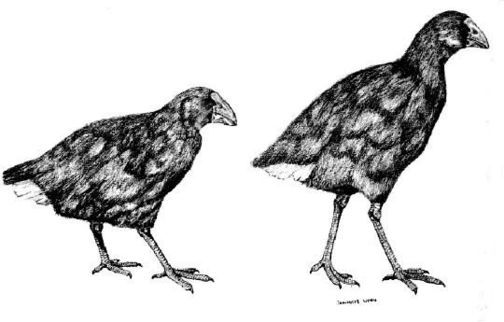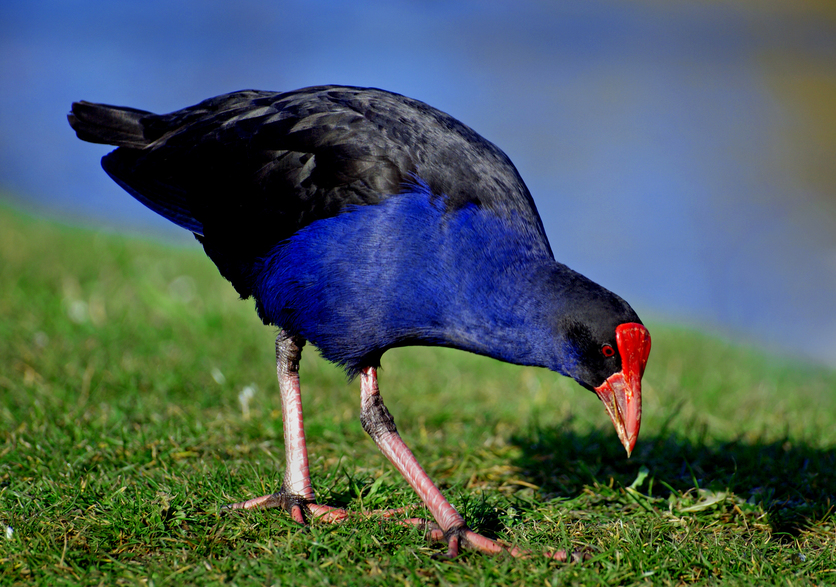Scientifically, takahē have been something of a mystery. For several decades, it was assumed that takahē were extinct in both the North and South Islands – until being rediscovered in 1948. There were other assumptions, too. Until 1996, it was thought the North Island takahē and South Island takahē were conspecific (members of the same species) and were migrants from Australia. Genetic and subfossil evidence is helping scientists gain a clearer understanding about takahē – their origins and evolution and how they are related to other New Zealand birds.
Nature of science
Our growing knowledge of takahē demonstrates two of the fundamental aspects of science – the tentative nature of scientific knowledge and the role of evidence in supporting new scientific claims.
Swamphens – an international flock
Takahē belong to the Rallidae or rail family. Their genus is Porphyrio – the Latin name for swamphen. Members of the Porphyrio genus live in the Mediterranean, Africa, Indonesia, Asia, Oceania and Australasia. Three species of Porphyrio are indigenous to New Zealand – the extinct North Island takahē (Porphyrio mantelli), the South Island takahē (Porphyrio hochstetteri) and the pūkeko (Porphyrio porphyrio melanotus). Although the takahē are endemic to Aotearoa New Zealand, pūkeko are also found in Australia, Indonesia and Papua New Guinea.
North Island takahē (Porphyrio mantelli)
Our knowledge of North Island takahē comes from Māori oral tradition, skeletal remains of the birds and other subfossil evidence. North Island Māori called this species moho or mohoau – meaning lonely. In 1847, Walter Mantell was the first European to find moho/takahē bones in the North Island. In 1894, Māori elders identified the skin of a large blue bird caught in the Ruahine Range as a mohoau. The skin, which no longer exists, is regarded as the only North Island takahē to be seen by Europeans and the last commonly known sighting by Māori. There are no images of the moho, but the Waitomo Museum of Caves houses a single skeleton.
Subfossil remains have been found over sites ranging from North Cape to Wairarapa. The sites include sand dunes, caves, middens and swamps. Scientists believe that moho preferred habitats along the edges of grasslands, scrub and forested lands. In these areas, the birds would have been easy to find, so predation by humans and introduced pests is the likely cause of their extinction.
South Island takahē (Porphyrio hochstetteri)
Until 70 years ago, our knowledge of South Island takahē was also limited. Māori called this species takahea – meaning to stand up tall and stamp one’s feet on the ground. There are 54 sites with subfossil remains throughout the South Island. These sites again include sand dunes, middens, caves and swamps, so it appears that southern takahē also preferred edge habitats where they could graze yet have shelter in which to retreat. South Island takahē escaped extinction because the Murchison Mountains are so isolated.
Interestingly, no takahē remains have been found on Stewart Island or other offshore islands around New Zealand.
Pūkeko (Porphyrio porphyrio melanotus)
The Australasian swamphen – better known in Aotearoa New Zealand by its Māori name pūkeko – is found throughout New Zealand and on the Chatham and Kermadec Islands, in mainland Australia and in other locations in the Pacific.
Pūkeko are recent arrivals in New Zealand. Subfossil remains have only been found in sites less than 400 years old. Genetically, pūkeko are closely related to their Australian counterparts, which also indicates a recent arrival.
Pūkeko are widespread throughout New Zealand. They eat a broad range of foods and their communal lifestyle promotes prolific breeding.
Māori oral traditions say pūkeko were introduced during their migration to Aotearoa New Zealand. However, pūkeko may have made their own way to New Zealand. In spite of their often clumsy appearance, the species has shown evidence of flying long distances over the ocean.
New Zealand swamphen origins
For many years, it was reasoned that takahē originated in Australia and had been blown across the Tasman Sea. Once in New Zealand and free of land-based predators, the North Island and South Island takahē evolved to become large flightless birds.
Research by Professor Steve Trewick, an expert in evolutionary ecology and genetics, has shown this is not the case. In 1996, Steve’s research revealed that the North Island takahē is a distinct species, different from the South Island takahē. Even more surprising, genetics reveal the North Island takahē has its origins with Australian swamphens, whereas the South Island takahē is genetically closer to South African swamphens. It appears that the two species arrived independently of each other. They landed on two different islands, but they followed the same evolutionary path to flightlessness. Experts think that, given enough time in a predator-free location, pūkeko would follow a similar evolutionary path.
New research
In 2023 new research uncovered how humans, rats and dogs pushed the takahē into Fiordland. New genetic research mapped this dramatic journey and the significant impact of humans and past climate change on the takahē. It has also led to new theories on their evolutionary history.
Related content
To access other Hub resources featuring takahē, check out the article Takahē – an introduction and the interactive Planning pathways using takahē resources.
Genetic evidence has also provided new information about another famous New Zealand bird. Find out more in the article Ruffling ancient feathers: kiwi’s Malagasy cousin.
Useful links
The New Zealand Geographic article Takahe – the bird that came back from the dead includes information about the takahē’s evolutionary history. The article also has comments from Professor Steve Trewick.
Visit New Zealand Birds Online to learn more about New Zealand’s swamphens: North Island takahē, South Island takahē and pūkeko. The information on these web pages highlights the similarities and differences between the bird species.
TKI uses the book Takahē: Back from the Brink to explore the science capability ‘Use evidence to support ideas'. The book is part of the Applications series, and copies may be available in New Zealand secondary schools. If not, check the book’s availability via Down the Back of the Chair or the National Library.
Alexander J. F. Verry, Eduard Mas-Carrió, Gillian C. Gibb, Ludovic Dutoit, Bruce C. Robertson, Jonathan M. Waters, Nicolas J. Rawlence, Ancient mitochondrial genomes unveil the origins and evolutionary history of New Zealand's enigmatic takahē and moho. Molecular Ecology 2023. https://doi.org/10.1111/mec.17227.




